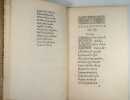ANACREON
Anacreontis teii odae.
Paris, Henri Estienne, 1554.
Reference : 12796
Edition princeps. Magnifiquement imprimée à l'aide des trois fontes des "grecs du roi", "aussi belle que rare" selon Brunet. Le texte grec est suivi de sa traduction latine et des commentaires d'Estienne. Couleur du dos passée. Très bel exemplaire, grand de marges, relié par Nicolas-Denis Derome (1731-1790) dit Derome le jeune, avec son étiquette. Brunet 1, 250. /// In-4 de (8), 110 pp., 1 f. blanc. Maroquin vert, dos orné, encadrement dorés sur les plats, tranches dorées. (Reliure du XVIIIe, Derome.) //// Editio princeps. "The book is magnificently printed in all three sizes of the "grecs du roi". ... This is the first book published under the imprint of Henri Estienne II." Schreiber 139. Very nice copy, with large margins, bound by Nicolas-Denis Derome (1731-1790), with its label.
Bookseller's contact details
Hugues de Latude
Hugues de Latude
06 09 57 17 07
Payment mode



Sale conditions
Books are guaranteed to be complete and in good condition unless otherwise stated.
2 book(s) with the same title
Anacreontis teii odae.
Paris, Henri Estienne, 1554.
Edition princeps. Magnifiquement imprimée à l'aide des trois fontes des "grecs du roi", elle est "aussi belle que rare" selon Brunet. Le texte grec est suivi de sa traduction latine et des commentaires d'Estienne. "The book is magnificently printed in all three sizes of the "grecs du roi". ... This is the first book published under the imprint of Henri Estienne II." Schreiber 139. Le vélin est un peu rétracté avec au second plat une restauration dans la partie supérieure et une petite lacune dans la partie inférieure. Cachet gratté sur le titre. Petite attaque d'un rongeur sur quelques millimètres dans la marge des 10 derniers feuillets. Bon exemplaire dans l'ensemble, grand de marges. Adams A-1001. Brunet 1, 250. /// In-4 de (8), 110 pp., 1 f. blanc. Vélin. (Reliure de l'époque.) ////
Anacreontis Teii Odae et fragmenta, graece et latine, cum notis
Trajecti ad Rhenum, Apud Guilielmum Kroon, Bibliop., 1732, in-8 (170x220cm), plein veau raciné, dos à 5 nerfs, décoré de fleurons, pièce de titre cuir, toutes tranches rouges, filets sur coupes, 315 pages Traduction latine des odes en regard du texte grec, accompagnées de notes. Attribuées à un poète lyrique grec du VIe siècle avant notre ère ces poésies chantent l'amour et les plaisirs de la table. Elles ont aussitôt inspiré les poètes de la Renaissance. Bel état de fraîcheur.
NB : LES QUESTIONS ET COMMANDES SONT TRAITEES DANS LES 48H, LES ENVOIS REPRENDRONT À PARTIR DU 4 DECEMBRE, MERCI.
 Write to the booksellers
Write to the booksellers





